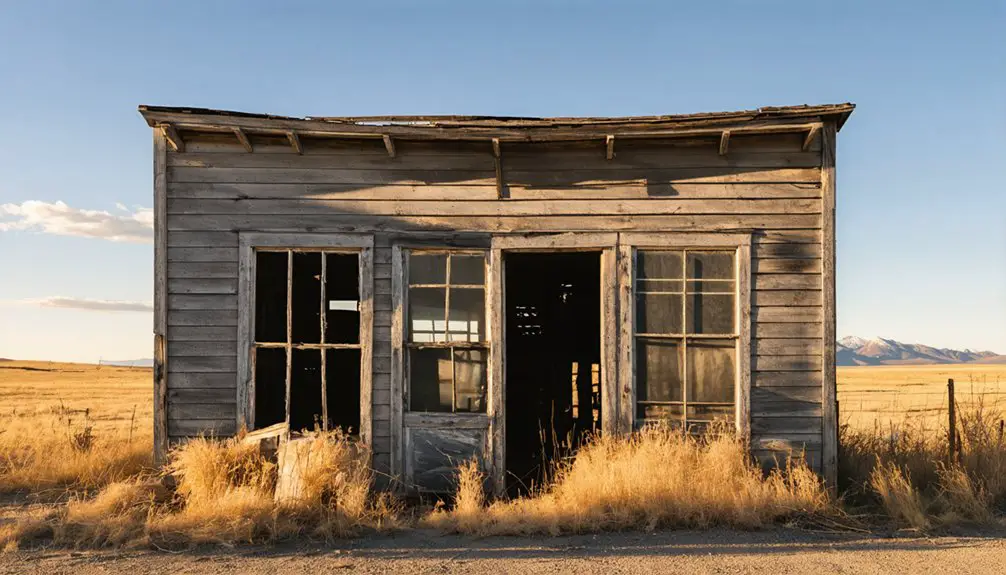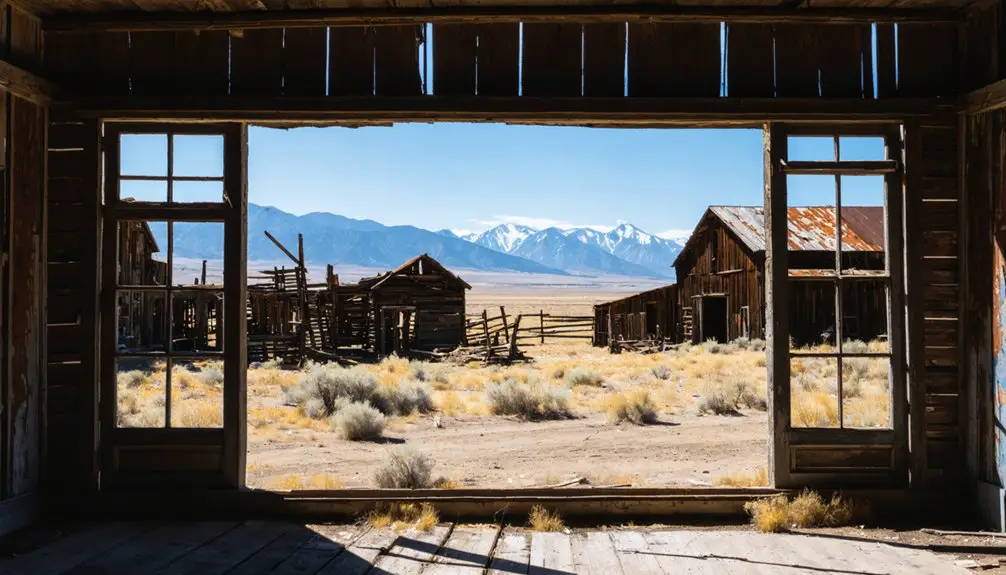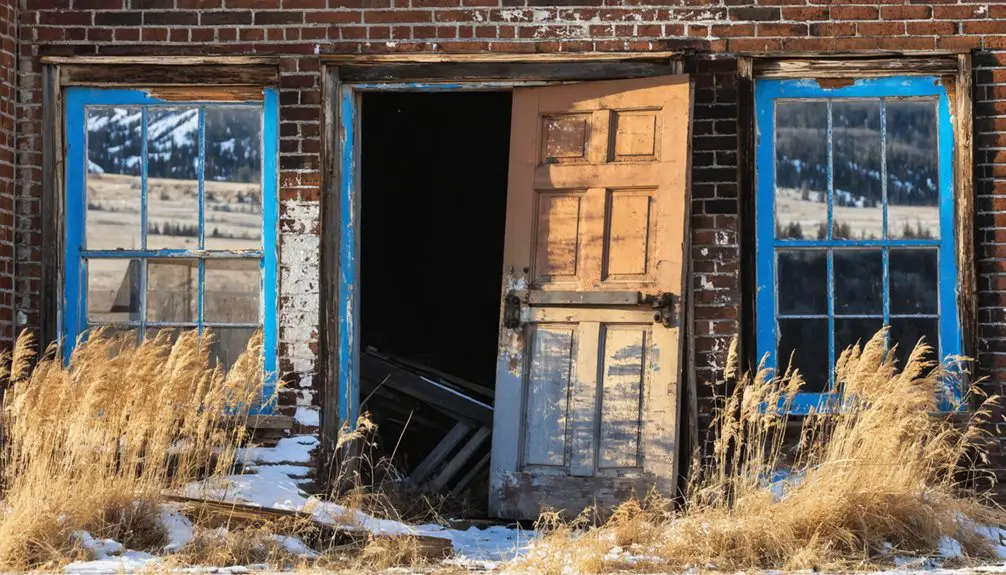You’ll find Thoeny, Montana at 48°52′37″N and 106°55′03″W, where weathered buildings and a historic cemetery mark what was once a thriving prairie community. Founded in 1915, the town peaked at 317 residents by 1920, boasting two general stores, thirteen saloons, and a blacksmith shop. Without railroad access, the population dwindled to 127 by 1930. Today, preservation efforts maintain the town’s remnants as a reflection of Montana’s frontier heritage, with countless stories waiting in its quiet streets.
Key Takeaways
- Thoeny, Montana, established in 1915, reached its peak population of 317 residents in 1920 before declining to a ghost town status.
- The town featured thirteen saloons, two general stores, a blacksmith shop, and a schoolhouse during its brief prosperous period.
- Lack of railroad access and economic pressures during the Great Depression contributed significantly to the town’s eventual abandonment.
- The Thoeny Cemetery remains as a historical landmark, preserving the memory of pioneer families from 1915 to 1930.
- Located at 48°52′37″N and 106°55′03″W, the site features weathered buildings and artifacts that showcase Montana’s frontier life.
The Rise of a Prairie Community (1915-1920)
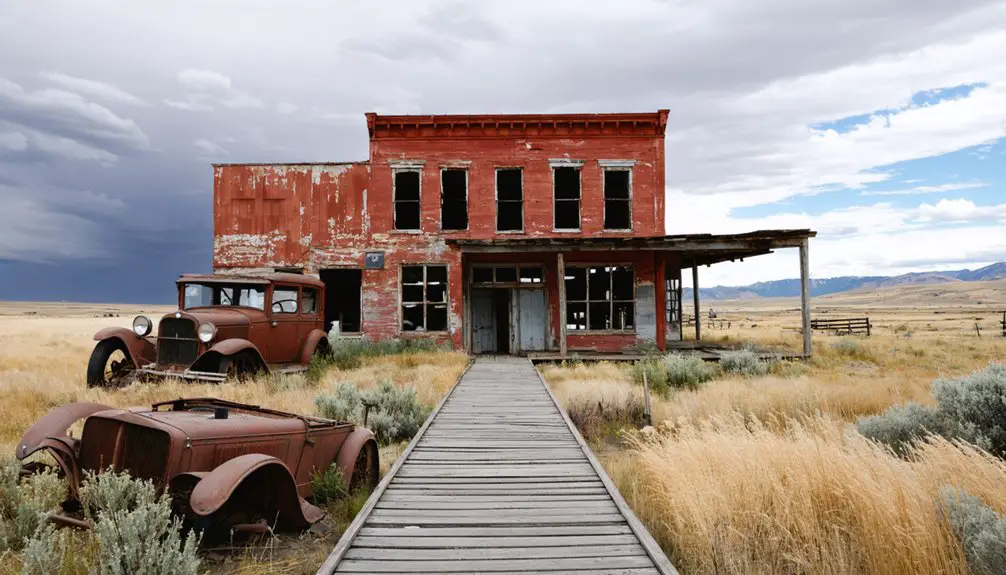
As settlers pushed northward into Montana’s vast prairie landscape, the small community of Thoeny emerged in 1915 along the Canadian border in Valley County. Named after its first postmaster, Jacob Thoeny, the settlement exemplified community resilience despite significant settlement challenges, including its lack of railroad access.
You’ll find that by 1920, Thoeny had grown to 317 residents and boasted crucial infrastructure that kept the community thriving. Two general stores supplied essential goods, while a blacksmith shop served the area’s agricultural needs. Just like the student research papers housed at Montana State University, the town’s history reflects the determination of early Montana settlers.
A local newspaper connected citizens to regional happenings, and the schoolhouse educated the settlement’s children. The establishment of a hilltop cemetery marked the community’s permanent presence, reflecting the settlers’ determination to build lasting roots in this remote prairie outpost.
Life Without Railroad Access
The absence of railroad access shaped Thoeny’s destiny more than any other factor in its brief history.
You’ll find transportation limitations created a ripple effect throughout the community, leading to devastating economic stagnation. Without rail connections, businesses couldn’t compete with neighboring towns, and farmers struggled to ship their products to distant markets. Much like the Montana mining towns that relied on freight wagons for supplies, Thoeny’s isolation severely limited its growth potential.
- Horse-drawn wagons and early motor vehicles became the only lifeline for goods and people.
- Weather-dependent dirt roads made year-round transportation unreliable.
- Higher shipping costs drove away potential investors and businesses.
You can trace the town’s decline through its population numbers, which plummeted from 317 in 1920 to just 127 by 1930.
While nearby railroad towns like Whitetail flourished, Thoeny’s isolation forced younger residents to seek opportunities elsewhere, ultimately sealing its fate as a ghost town.
Early Business and Commerce
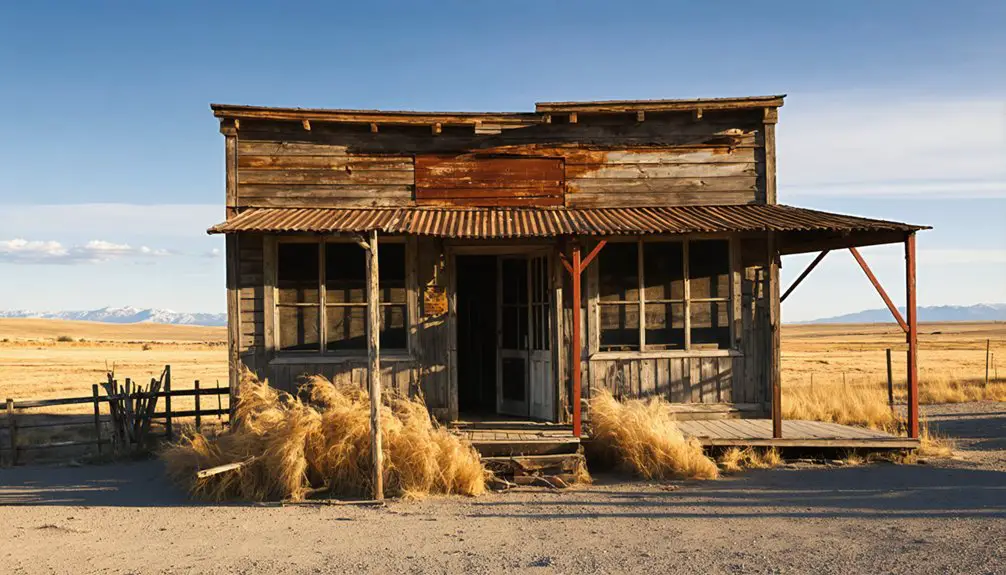
Despite its remote location, Thoeny’s early commercial district bustled with activity between 1915 and 1920, anchored by two general stores that supplied essential goods to local miners and farmers.
You would’ve found a crucial blacksmith shop servicing tools and equipment, while the local newspaper kept residents informed of community happenings.
The establishment of a post office under Jacob Thoeny in 1915 helped connect this frontier town to the outside world.
Like many mining communities of that era, Thoeny could have supported up to thirteen saloons during its peak years.
Much like the fate of the Green Eagle mine, many local businesses struggled when resources were depleted.
With a peak population of 317 residents by 1920, you could’ve witnessed a thriving small-town economy typical of early Montana settlements.
However, when the population plummeted to 127 by 1930, many businesses couldn’t survive.
While the lack of railroad access limited growth potential, Thoeny’s early commercial infrastructure supported a self-sufficient community until its gradual decline.
Population Changes Through the Decades
You’ll find Thoeny’s most prosperous period reflected in its peak population of 317 residents in 1920, though this number would dramatically decrease to 127 by 1930.
Like many ghost towns, the buildings and structures that remain serve as historical artifacts reflecting an era of economic boom and decline. The separation of the Barnard census district, which counted 76 residents, coupled with Thoeny’s lack of railroad access, accelerated the town’s decline.
This pattern of population decline mirrors other Montana mining communities like Comet City, which supported just 300 mining residents during its peak operations.
Population Peak Then Decline
While many western towns experienced rapid growth in the early 1900s, Thoeny’s population trajectory reached its zenith in 1920 with 317 residents. The town’s population stability was reflected in its established businesses and schoolhouse, showing signs of economic resilience despite lacking railroad access.
By 1930, you’d have witnessed a dramatic shift as Thoeny’s population plummeted to 127 residents. This decline continued into the following decades, leading to the town’s eventual ghost town status. Much like the mining towns of Southwest Montana’s region, Thoeny faced significant challenges in maintaining its population.
Key factors in the town’s depopulation included:
- The secession of Barnard census district, which took 76 residents with it
- Integration into the Hinsdale Rural CCD by 1940, marking the end of independent population counts
- Economic pressures from the Great Depression and World War II drawing residents away
Rural Migration Patterns
Thoeny’s population decline mirrored broader rural migration patterns that shaped Montana’s demographic landscape throughout the 20th century.
You’ll find that economic downturns and declining agricultural opportunities drove residents, especially younger generations, to seek prospects elsewhere. The absence of railroad access and loss of key businesses severely limited the town’s growth potential.
Rural demographics shifted as migration drivers evolved. While early settlers came for mining and homesteading opportunities, later patterns showed younger people (18-24) moving to larger towns for education and jobs.
Though Montana’s seen recent in-migration of families and middle-aged adults to amenity-rich rural areas, towns like Thoeny, lacking infrastructure and economic opportunities, couldn’t retain their populations.
The town’s story reflects how transportation access and economic viability determined the fate of many rural Montana communities.
The Schoolhouse Legacy
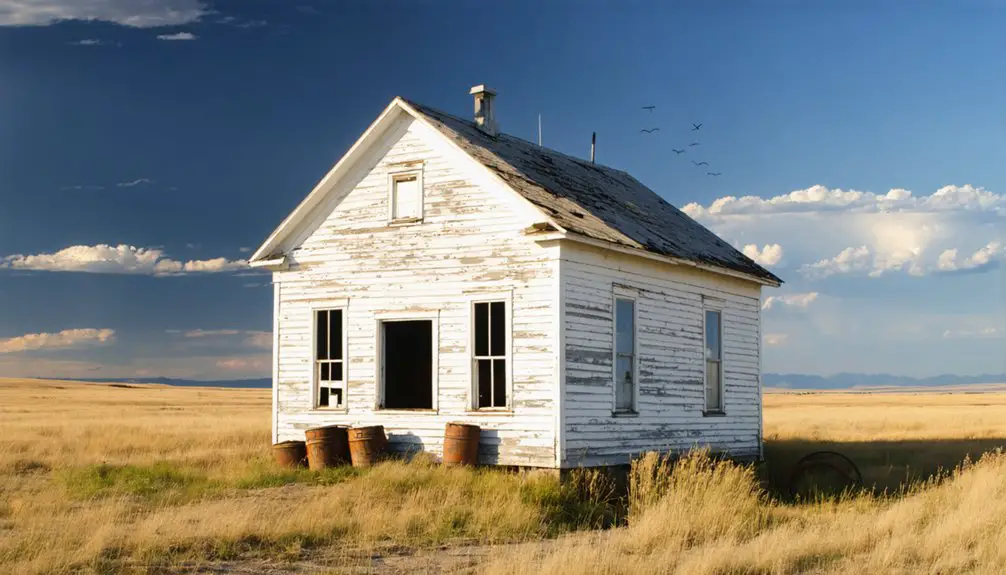
Among the few remaining structures in the ghost town of Thoeny, the historic schoolhouse stands as a tribute to early 20th-century frontier education.
Built between 1910 and 1915, this schoolhouse preserves schoolhouse memories from Montana’s homesteading era, when the town’s population peaked at 317 residents. The educational legacy of this simple wood-frame building reflects the pioneering spirit of early settlers who valued learning despite their isolation.
You’ll find the schoolhouse exemplified these crucial characteristics:
- Served as both an educational facility and essential community gathering space
- Operated without electricity, teaching basic literacy and numeracy to local children
- Represented the aspirations of homesteading families seeking to build lasting communities
Today, it remains one of Montana’s numerous historic one-room schools, symbolizing the determination of frontier educators and students.
Cemetery Stories and Local Heritage
Today you’ll find Thoeny’s cemetery perched atop a peaceful hill, serving as one of the last physical reminders of this once-vibrant frontier community.
While many of the burial records have been lost to time, the site holds the remains of pioneer families who shaped northern Valley County‘s early development between 1915 and 1930.
Local preservation efforts now focus on maintaining this sacred ground, ensuring that future generations can connect with the area’s heritage through this historically significant landmark.
Eternal Rest on Hilltop
Perched atop a windswept hill in Valley County, Montana, the Thoeny cemetery stands as a poignant tribute to the area’s frontier heritage.
You’ll find this eternal rest site overlooking what remains of a once-thriving homesteader community, where hilltop views stretch across the rugged northern landscape near the Canadian border.
The cemetery’s strategic placement reflects the practical wisdom of early 20th-century settlers, who chose this elevated location for its accessibility and visibility.
Today, it serves as one of the few remaining physical landmarks of Thoeny’s past, alongside:
- Simple grave markers telling stories of pioneer families
- Family plots documenting early settlement patterns
- Silent testimonials to the hardships and triumphs of frontier life
These grounds preserve the legacy of those who shaped this remote corner of Montana.
Pioneer Family Burial Records
The weathered headstones and burial records of Thoeny Cemetery tell rich stories of the area’s pioneer families, preserving essential historical and genealogical information about the region’s early settlers.
You’ll find burial traditions reflected in family plots clustered together on the hillside, where Jacob Thoeny and other founding residents rest.
Through genealogical research of these grave markers and burial registers, you can trace the movement of families between Canada and Montana, understanding their migration patterns and community ties.
Birth dates, death records, and occasional references to occupations or origins offer valuable insights into frontier life.
Local heritage groups continue documenting these precious records, while descendants return to maintain connections with their pioneering ancestors through preservation efforts and annual remembrance ceremonies.
Preserving Sacred Ground Today
While Montana’s ghost town cemeteries face ongoing challenges from natural decay and neglect, innovative preservation technologies and community initiatives have emerged to protect these sacred spaces.
You’ll find local preservation efforts focusing on three key areas:
- Story mapping projects that digitally capture life histories of those buried, enhancing community engagement
- Training workshops and online resources tailored to Montana’s unique environmental conditions
- Collaborative partnerships between museums, historical societies, and volunteer groups
You can participate in preservation efforts through various non-profit organizations like the Montana Ghost Town Preservation Society.
Despite preservation challenges including weather damage and limited funding, your involvement helps safeguard these historic sites.
Through special license plate funding and local volunteer work, you’re able to contribute to maintaining these important cultural landmarks for future generations.
Exploring Present-Day Remnants
Standing as silent witnesses to Montana’s mining era, Thoeny’s remaining structures offer visitors a tangible connection to frontier life.
As you walk among the weathered buildings, you’ll discover simple wooden constructions that exemplify late 19th-century architectural significance. Historical preservation efforts have maintained several original structures, including schoolhouses and mining-related buildings, though many now stand in various states of decay. Local park rangers provide helpful information and recommendations to enhance your understanding of the site.
You can explore the site through well-marked paths that lead you past interpretive signs and historical markers. These plaques help you understand the function and importance of each remaining building.
While some structures are accessible only from the exterior, you’ll still find compelling evidence of frontier life through visible artifacts and mining equipment scattered throughout the grounds.
Mapping the Ghost Town’s Location
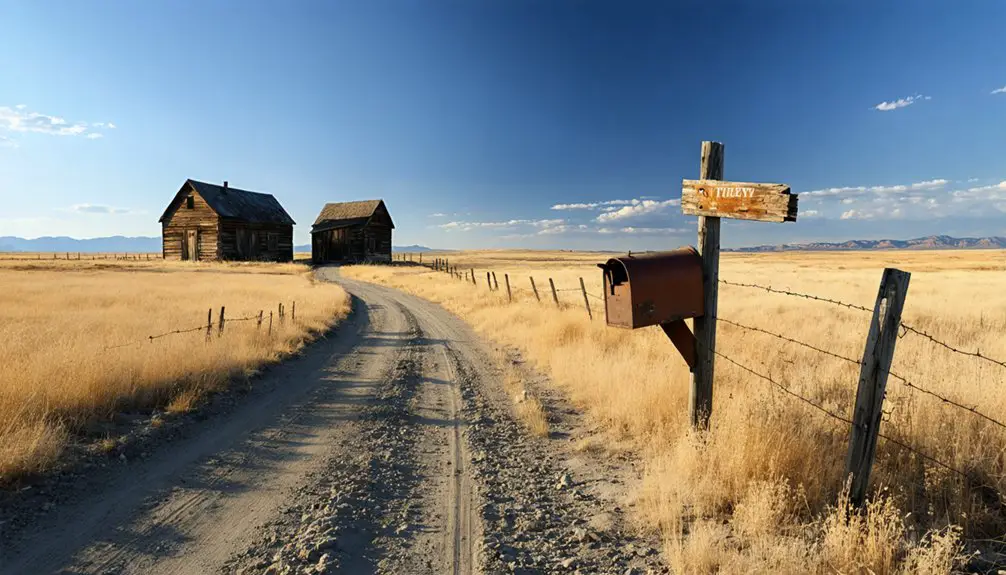
Located at precisely 48°52′37″N and 106°55′03″W, Thoeny rests in northern Valley County, Montana, near the Saskatchewan border.
You’ll find this ghost town‘s geography marked by open terrain and rolling hills, with historical landmarks including a hilltop cemetery and an old schoolhouse serving as key reference points.
To navigate to Thoeny’s location, you’ll want to:
- Use USGS 7.5″ topographical maps for detailed terrain features
- Combine GPS coordinates with BLM legal land descriptions
- Reference nearby towns of Hinsdale and Opheim as waypoints
The remote site lies within Mountain Time Zone, and you can access it via rural roads.
For the most accurate navigation, combine satellite imagery with topographical maps, as the ghost town’s isolated setting demands careful planning before your visit.
Historical Significance in Valley County
The story of Thoeny’s historical importance begins in 1915 when Jacob Thoeny established his namesake settlement in northern Valley County.
Within just three years, you’d have found a thriving frontier community complete with general stores, a newspaper, and a blacksmith shop, all serving the region’s agricultural practices.
Frontier life flourished quickly in Thoeny, as stores, press, and trade emerged to support local farming communities.
Despite lacking railroad access, Thoeny forged strong cultural connections with nearby communities and even across the Canadian border.
The town’s peak population of 317 in 1920 reflected the area’s promising start. You can still trace this legacy through the schoolhouse and hilltop cemetery, which stand as monuments to the community’s educational values and pioneer spirit.
Though Thoeny later merged into the Hinsdale Rural Census County Division, its role in Valley County’s development remains significant.
Preserving Montana’s Rural Past
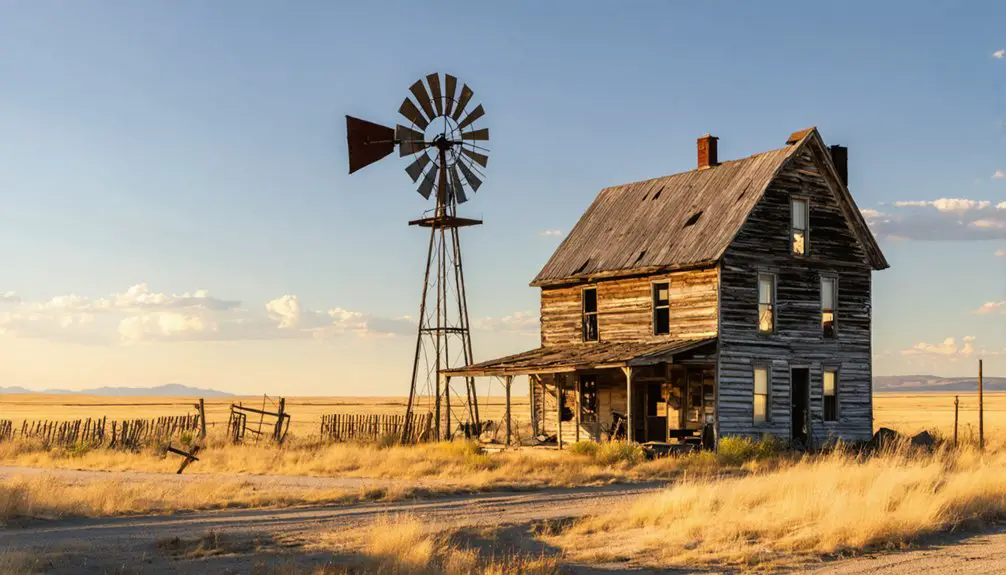
When you explore Thoeny’s remaining structures today, you’ll notice the characteristic challenges that Montana’s rural ghost towns face, including weather damage and the ongoing need for stabilization efforts.
Local preservation groups have worked to document the town’s historic buildings through detailed photographs and architectural surveys, creating valuable records for future restoration work.
You can support these preservation initiatives by participating in Valley County’s heritage projects, which aim to protect sites like Thoeny through community engagement and educational programs. Groups like the Montana Historical Society help guide these preservation efforts through educational resources and technical support.
Historical Building Restoration Efforts
Recognizing the significant importance of preserving Montana’s architectural heritage, restoration experts have implemented extensive techniques to safeguard Thoeny’s historic structures.
You’ll find historical techniques that focus on maintaining original building materials while addressing preservation challenges in remote locations.
Key restoration initiatives include:
- Meticulous architectural reconstruction using period-appropriate materials and methods
- Integration of salvaged historical artifacts to enhance authenticity and context
- Implementation of protective measures against harsh weather conditions
These efforts aren’t just about preserving buildings – they’re about maintaining your connection to Montana’s rich past.
Following the example of Charlie and Sue Bovey, pioneering preservationists who saved numerous historic structures across Montana in the 1940s, dedicated preservationists work to guarantee that Thoeny’s structures continue telling their story for future generations to explore and appreciate despite funding constraints and logistical hurdles in this rural setting.
Local Community Heritage Projects
Montana’s rural communities have embraced an impressive array of heritage preservation projects, backed by substantial grant programs and grassroots initiatives.
You’ll find towns like Philipsburg breathing new life into Victorian-era facades, while Deer Lodge’s Rialto Theatre stands as a symbol of community engagement in historic preservation.
Through programs like the Montana Historical Society’s RMRH grants and the Foundation for Montana History’s funding, you can access between $10,000 and $100,000 for local heritage projects.
These initiatives support more than just building restoration – they’re preserving cemeteries, collecting oral histories, and fostering heritage education.
The newly launched Preserve Montana Trades Corps guarantees you’ll have skilled craftspeople to maintain these treasured sites, creating a sustainable future for Montana’s historic places while strengthening local economies.
Frequently Asked Questions
What Was the Primary Source of Water for Thoeny’s Residents?
As clear as a mountain stream, you’ll find the community needs were met through natural water sources like local creeks and groundwater wells, which served as the primary supply system.
Were There Any Notable Crimes or Lawlessness Reported in Thoeny?
You won’t find documented crime history or law enforcement records indicating notable lawlessness in this small community – no evidence suggests significant criminal activity occurred during its brief period of settlement.
What Happened to Most Buildings After the Town Was Abandoned?
You’ll find that abandoned structures gradually succumbed to natural decay, with wind, rain, and snow taking their toll. Without historical preservation efforts, many buildings collapsed while others fell to demolition or vandalism.
Did Any Famous People Ever Visit or Live in Thoeny?
Time has a way of forgetting the small places. You won’t find any famous visitors or historical figures in Thoeny’s story. Only Jacob Thoeny, the first postmaster, left a notable mark.
What Native Tribes Inhabited the Area Before Thoeny Was Established?
You’ll find the Blackfeet Nation primarily inhabited this territory, with Cree and Assiniboine peoples also present. Their native history and tribal culture deeply influenced the region through hunting, trade, and spiritual practices.
References
- https://brainly.infogalactic.com/info/Theony
- https://en.wikipedia.org/wiki/Thoeny
- https://www.montanaliving.com/blogs/destinations/explore-montana-ghost-towns
- https://www.mountain-home.com/blog/vacation-planning/guide-montana’s-ghost-towns
- https://visitmt.com/things-to-do/ghost-towns
- https://www.blm.gov/sites/default/files/docs/2021-07/THE ROAD TO GARNET’S GOLD (002).pdf
- https://archiveswest.orbiscascade.org/ark:80444/xv42443
- https://www.mtmemory.org/nodes/browse
- https://mhs.mt.gov/pubs/Magazines/
- https://www.youtube.com/watch?v=nBcifd-62Ek
